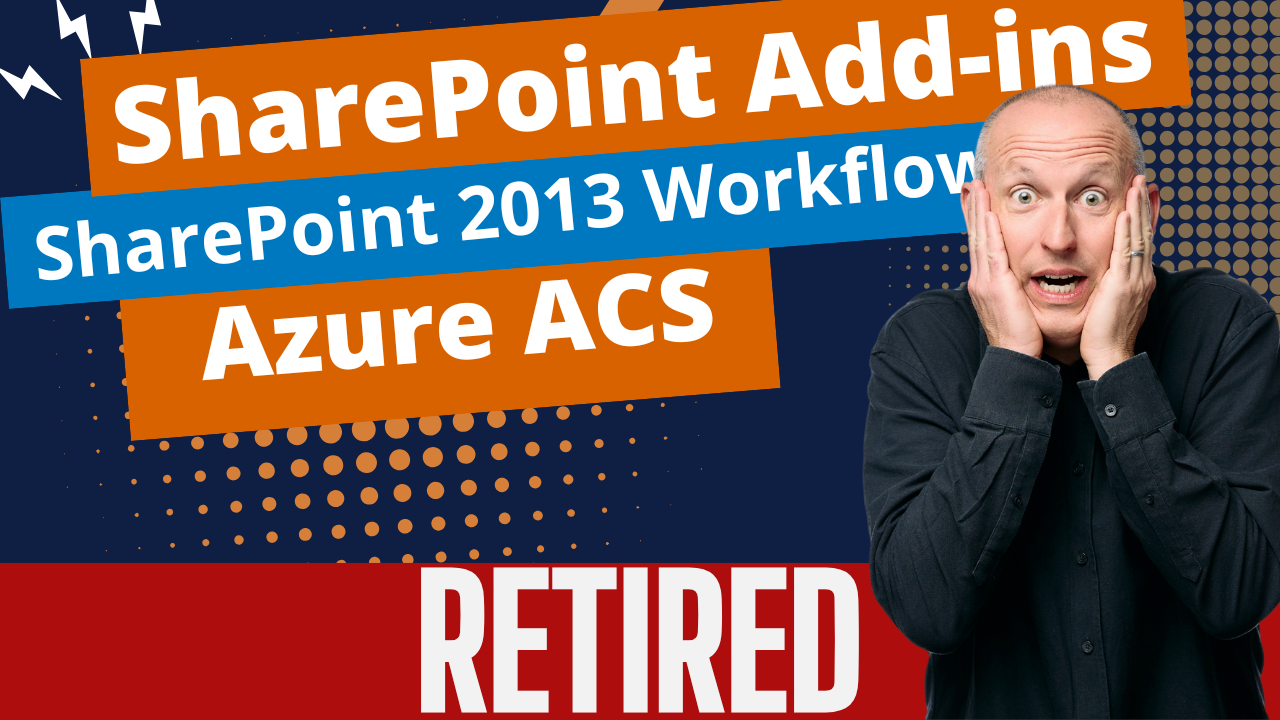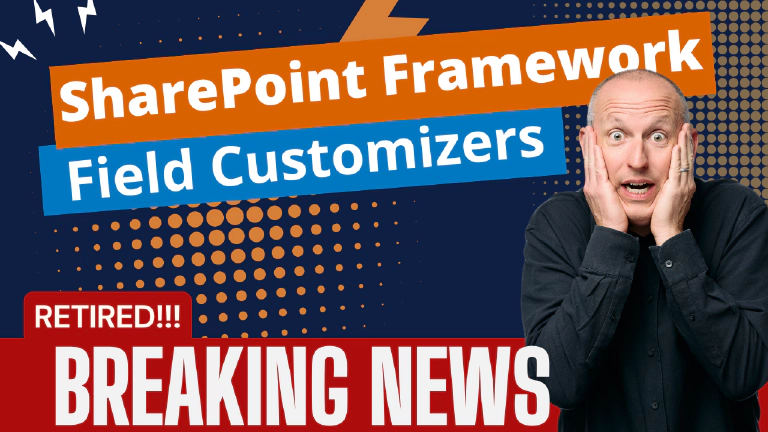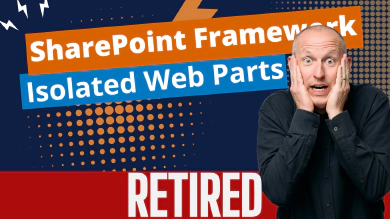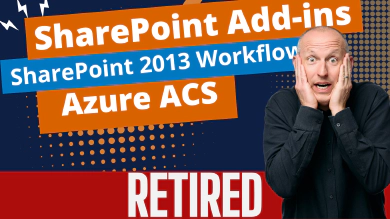UPDATE: Maybe They Aren't Retired Yet...
I received the following comment on Thursday, June 18 ~2p ET from Microsoft after this article was published… looks like they’re taking a step back and re-evaluating their decision
Microsoft: “We are evaluating deprecating FieldCustomizer. We are working with you all to understand the impact. We don’t have a date to share for this deprecation. When we do announce a date, it will be at least a year in the future from that announcement.”
Microsoft announced they’re retiring SharePoint Framework field customizers in June 2026, eliminating a key extensibility option developers have relied on for nearly eight years.
In a buried message center announcement on June 13, 2025, Microsoft revealed that SharePoint Framework (SPFx) field customizers will stop working on June 30, 2026. This decision removes critical functionality that thousands of organizations depend on for customizing SharePoint list columns with business logic and interactive elements.
In this article, you’ll learn what field customizers are, the details of Microsoft’s announcement, the recommended alternatives, and why this retirement represents a significant loss for SharePoint developers and organizations.
What are SharePoint Framework field customizers?
Field customizers are one of three extension types supported by the SharePoint Framework. Microsoft created this feature to bridge the functionality gap left when they moved from SharePoint’s classic mode to the modern experience.
In classic SharePoint, developers used JSLink or Client Side Rendering (CSR) to customize how columns appeared in lists and forms using JavaScript. This allowed for rich customizations including business logic, validation, and interactive elements that went far beyond simple formatting.
Microsoft released field customizers in 2017, several months after the initial SPFx release. Initially, they only supported read-only scenarios in lists, but Microsoft promised to add write operations for forms within a few months. While they never delivered on that promise for field customizers, they eventually introduced list form customizers years later, though without proper deployment mechanisms.
Field customizers gave developers the power to customize column rendering using JavaScript, add custom business logic, and trigger actions that extended beyond SharePoint’s boundaries. This made them invaluable for creating sophisticated user experiences within SharePoint lists and document libraries.
The retirement announcement: MC1094051
On Friday, June 13, 2025, Microsoft quietly published announcement MC1094051 in the Microsoft 365 Message Center titled “Support Update for SharePoint Framework Field Customizers in Lists and Document Libraries.”
Support Update for SharePoint Framework Field Customizers in Lists and Document Libraries
https://admin.microsoft.com/AdminPortal/home#/MessageCenter/:/messages/MC1094051
![[MC1094051] SPFx Field Customizer Retirement [MC1094051] SPFx Field Customizer Retirement](/img/logos/microsoft-1920x1080_hu_9695b3b19626c4f7.webp)
The announcement states that SharePoint Framework field customizers will be retired from SharePoint lists and document libraries on June 30, 2026. As of the announcement date, field customizers are officially deprecated but continue to function normally.
When the retirement date arrives, the field customizer JavaScript bundles will no longer load on pages. SharePoint Online will revert to using the default rendering defined by each column’s underlying data type. Microsoft emphasizes that other SPFx extensions, including app customizers, list form customizers, and command set extensions, will continue functioning normally.
Microsoft’s recommended alternatives
Microsoft suggests two primary alternatives to replace field customizer functionality:
- Declarative column formatting: This JSON-based approach allows visual customization of columns without custom code. While useful for basic formatting and simple conditional logic, it cannot execute custom JavaScript or implement complex business logic.
- Power Apps: Microsoft recommends using Power Apps for scenarios requiring more sophisticated functionality. However, this represents a fundamental shift from embedded customizations to separate applications.
Impact and functionality loss
This retirement creates significant challenges for organizations and developers who have invested in field customizer solutions over the past eight years.
Custom business logic in list & column rendering no longer possible
The most critical loss is the inability to implement custom business logic within column rendering. Declarative column formatting simply cannot replace JavaScript-based field customizers that perform calculations, call external APIs, or implement complex validation logic.
Reliable and secure deployment at scale no longer possible
Organizations also lose the ability to deploy column customizations in a secure, reliable way at enterprise scale. Field customizers packaged within SharePoint solution packages (*.sppkg) could be deployed through app catalogs using automated Application Lifecycle Management (ALM) processes. Declarative column formatting and Power Apps lack this deployment sophistication - they’re limited to manual one-time customizations.
The growing retirement list of M365 & SharePoint development extensibility options
This retirement adds to an already substantial list of Microsoft 365 platform retirements scheduled for 2026:
- Azure Access Control Service (ACS): April 2, 2026
- SharePoint 2013 Workflows: April 2, 2026
- SharePoint Add-ins: April 2, 2026
- SPFx Isolated Web Parts: April 2, 2026
I’ve written above these retirement notices previously in the following articles:
This is the definitive guide to the Microsoft 365 retirements announced in 2023: SharePoint Add-in model, SharePoint 2013 workflows, and Azure ACS.
https://www.voitanos.io/blog/sharepoint-add-in-model-retirement-other-services-unpacked/

Microsoft is at it again... building off all the retirement notices in 2023, Microsoft is as it again killing off a SharePoint Framework (SPFx) feature.
https://www.voitanos.io/blog/sharepoint-framework-domain-isolated-webpart-retirement/

My take on the retirement announcement
This announcement represents more than just a feature retirement; it signals troubling patterns in Microsoft’s M365 management approach.
Microsoft provided zero advance notice to the developer community, failed to solicit input from MVPs and insiders who could have provided valuable feedback, and showed no consideration for the impact on existing solutions that organizations have relied on for years.
The timing and manner of this announcement erodes trust in the SharePoint Framework as a reliable development platform.
When Microsoft introduced SPFx in 2016, they positioned it as the future of SharePoint development with long-term support and commitment. This sudden retirement contradicts those assurances.
I suspect this decision stems from internal conflicts between the SharePoint Framework team and the SharePoint Lists team. In 2024, the Lists team launched a new user experience that initially broke all SPFx customizations because they failed to test compatibility with existing extensions. While they quickly patched the issue by falling back to the old rendering when customizations were present, the subsequent fixes have been slow, problematic, and poorly executed.
This raises legitimate concerns about the future of other SPFx extensions. If field customizers can be retired due to incompatibility with new list experiences, what prevents the same fate for command set extensions or other SPFx features?
Coupled with the retirement of SPFx field customizers and combined with other recent news and decisions in the Microsoft 365 development and SPFx space, while it pains me to say this, I can’t shake the feeling that they’ve betrayed not just my trust, but the trust in the SPFx developer community.
Frankly, my confidence in the Microsoft 365 development ecosystem and SPFx in general is at an all time low.

Andrew Connell
Microsoft MVP, Full-Stack Developer & Chief Course Artisan - Voitanos LLC.
My guidance: what should you do?
Organizations using field customizers should begin planning their transition strategy immediately. Start by auditing existing field customizers to understand their functionality and determine which features can be replicated using declarative column formatting.
For customizations requiring business logic or external integrations, evaluate whether Power Apps provides adequate alternatives or if custom solutions using other Microsoft 365 extensibility options might work better. But, strongly consider the limitations and baggage with these alternatives. Are they worth it?
Consider this retirement when making future platform decisions. The precedent it sets should factor into your organization’s long-term SharePoint development strategy and technology investment decisions.
Looking ahead
The retirement of SharePoint Framework field customizers represents a significant loss of functionality and flexibility for SharePoint developers and organizations. While Microsoft offers alternatives, none fully replace the capabilities that SPFx field customizers provide.
This decision highlights the importance of understanding platform risks when building mission-critical customizations. It also underscores the need for Microsoft to improve communication and collaboration with the developer community on decisions that affect existing investments.
What’s your experience with field customizers?
How will this retirement impact your organization’s SharePoint solutions?
Share your thoughts and concerns in the comments below!
I’d love to hear how the community plans to navigate this transition.

Microsoft MVP, Full-Stack Developer & Chief Course Artisan - Voitanos LLC.
Andrew Connell is a full stack developer who focuses on Microsoft Azure & Microsoft 365. He’s a 21-year recipient of Microsoft’s MVP award and has helped thousands of developers through the various courses he’s authored & taught. Whether it’s an introduction to the entire ecosystem, or a deep dive into a specific software, his resources, tools, and support help web developers become experts in the Microsoft 365 ecosystem, so they can become irreplaceable in their organization.







